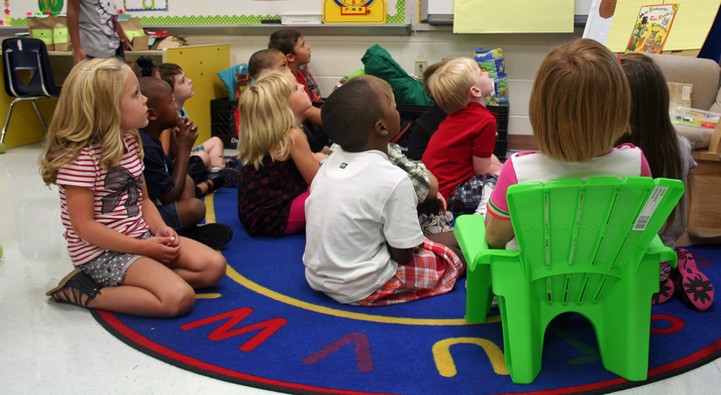
During the preschool years, children develop new thinking skills and become competent at using language to communicate. These newly developed thinking and language skills enable preschoolers to begin solving complex problems, asking and answering questions, and using their imagination to create and act out stories. Child care providers can support thinking and language development in preschoolers through conversations, reading, math and science activities, creative questions, and opportunities to pretend. The following are common milestones of thinking and language development in children ages 3 to 5.
At Age 3, Most Preschoolers…
- Use understandable speech 75-80 percent of the time
- Can talk in complete sentences of three to five words, such as, “Mommy is drinking juice” or “ There is a big dog.”
- May stumble over some words, but this is not necessarily a sign of stuttering
- Listen attentively to short stories
- Like familiar stories told without any changes in words
- Repeat words, sounds and familiar rhymes
- Can tell simple stories using pictures or books
- Enjoy singing and can carry a simple tune
- May start to understand what “now,” “soon” and “later” mean
- Are able to ask who, what, where and why questions
- Can stack about five to seven blocks
- Enjoy pounding, rolling and squeezing clay or play dough
- Can put together a six-piece puzzle
- Can draw a circle and square
- Can recognize everyday sounds
- May be able to match object and picture
- Identify common colors
- Can count two or three objects
At Age 4, Most Preschoolers…
- Can place objects in a line from largest to smallest
- Can recognize some letters if taught
- May be able to print their name
- Recognize familiar words in simple books or signs (example: STOP sign)
- Can understand the concepts of tallest, biggest, same, more, on, in, under and above
- Can count one to seven objects out loud
- Understand the order of daily routines — breakfast before lunch, lunch before dinner, dinner before bedtime
- Can speak fairly complex sentences, such as, “The baby ate the cookie before I could put it on table.”
- May enjoy simple songs, rhymes and nonsense phrases
- Can adapt their language to the listener’s level of understanding (e.g., say to baby sister, “Daddy go bye bye” but say to mother, “Daddy went to store to buy food.”)
- Can learn their full name, address and phone number if taught
- May ask and answer who, what, when, why, where questions
- Can continue an activity for 10-15 minutes
- May be able to name six to eight colors and three shapes
- May be able to follow two unrelated directions: “Put your milk on the table and put your coat on.”
At Age 5, Most Preschoolers…
- Know basic colors like red, yellow, blue, green orange
- Can memorize their address and phone number
- Understand that stories have a beginning, middle and end
- May enjoy telling their own stories
- Understand that books are read from left to right, top to bottom
- May enjoy riddles and jokes
- Begin drawing pictures that represent animals, people and objects
- May enjoy tracing or copying letters
- Can sort objects by size
- Can identify some letters of the alphabet and a few written numbers
- Understand “more,” “less” and “same”
- Understand “before” and “after,” “above” and “below”
- Can count up to 10 objects
- Are project-minded in their play; plan out buildings, play scenarios and drawings
- Are interested in cause and effect
For More Information
To learn more about preschoolers’ development, and to find activities and materials that support preschoolers’ development, take a look at the following eXtension Alliance for Better Child Care articles:
- What Child Care Providers Can Expect in Preschoolers’ Physical Development
- What Child Care Providers Can Expect in Preschoolers’ Social and Emotional Development
- Unique Thinking Skills in Preschool-age Children
- Age-Appropriate Toy Ideas for Child Care
- The Development of Creative Art Abilities in 3- to 5- Year-Olds
- Three “Bs” in Child Care: Blocks, Balls, and Books
If you are looking for specific activities to use with preschoolers, check out the Hands-on Activities for Child Care and Story-Stretching Ideas for Child Care searchable databases.
Photo by taz + belly / CC BY http://creativecommons.org/licenses/by/2.0/
